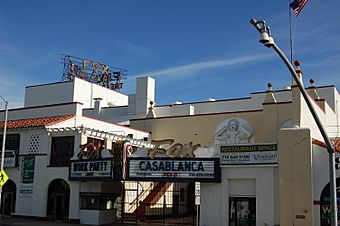Fox Theatre (Fullerton, California) facts for kids

Street view of Fullerton Fox Theatre
|
|
| Address | 510 N. Harbor Boulevard Fullerton, California United States |
|---|---|
| Public transit | Orange County Line |
| Type | Movie palace |
| Capacity | 900 |
| Opened | 1925 |
| Closed | 1987 |
| Website | |
|
Fox Fullerton Theatre Complex
|
|
| Location | Fullerton |
| Built | 1925 |
| Architect | Raymond M. Kennedy |
| Architectural style | Italian Renaissance |
| NRHP reference No. | 06000948 |
| Added to NRHP | October 25, 2006 |
The Fox Theatre is a historic movie theater in Fullerton, California. It is located on Harbor Boulevard. This grand building was built in 1925. It was once part of the famous chain of Fox Theatres. The theater closed its doors in 1987 and was left empty for many years. Today, a group called the Fullerton Historic Theatre Foundation is working hard to raise money and bring the theater back to life.
A local businessman named C. Stanley Chapman had the theater built. It was designed to be a place for both vaudeville shows (live performances with singing, dancing, and comedy) and silent movies. The building also had shops and a café next to it. Its style was inspired by Italian Renaissance architecture, which means it looked like old Italian buildings. Over the years, the building has changed a lot with new parts added.
Contents
History of the Fox Theatre
The Fox Theatre was built between 1924 and 1925. C. Stanley Chapman, whose father was Fullerton's first mayor, led the project. The building was designed for different uses. It had a main theater for vaudeville acts and silent movies. There was also a shopping area and a two-story café.
Changing Names and Locations
When it first opened, the theater was called Chapman's Alician Court Theatre. This name honored Chapman's wife, Alice Ellen. But as new owners took over, the theater's name changed several times. It was known as the Mission Court Theatre, Universal Mission Court Theatre, and Fox Mission Theatre. Finally, it became the Fox Theatre.
The first manager was Harry Lee Wilber, who was C. Stanley Chapman's father-in-law. He used to manage another theater in Fullerton before coming to the Fox. The theater's address also changed over time. It started at 500 North Spadra Boulevard (now Harbor Boulevard). Later, a commercial building was added next to it. Today, the Fox Theatre is located at 510-512 North Harbor Boulevard.
Architectural Style and Design
The theater's architect was Raymond M. Kennedy. He worked for a company called Meyer & Holler. This company finished building the theater in 1925. Meyer & Holler were famous for designing many buildings in Hollywood during the 1920s. They created well-known places like Grauman's Egyptian Theatre and the TCL Chinese Theatre. They also built many major film studios. This means Meyer & Holler played a big part in shaping the look of the early entertainment industry in Southern California. The Fox Fullerton Theatre is their most important building in Orange County.
When it opened, the Fox Theatre was the most impressive building of its kind in northern Orange County. It was designed in the Italian Renaissance style. It was a "movie palace" that showed off the glamour of Hollywood. People gathered there for news, entertainment, and to socialize. The theater had a special outdoor courtyard that acted like a lobby. This was a new idea that let people see the crowds gathering, creating excitement. The original complex also had a tea room run by Alice Chapman. This space was later rented out as a restaurant. When the theater reopens, the tea room will become part of it again.
Art and Murals
The theater has another special feature: six large murals. These were created by Anthony Heinsbergen and Company. This company was one of the best at decorating buildings during that time. Their work can be seen in places like Los Angeles City Hall and the Biltmore Hotel.
The decorative painter for the theater was John Gabriel Beckman. He worked for Meyer & Holler at the time. He was responsible for the beautiful artwork in the main and mezzanine lobbies. He also designed the original curtains. Later, he designed murals for the Avalon Casino and became a set designer for Paramount Pictures. The original murals at the Fox were painted over in the 1950s during the theater's first renovation. However, the proscenium (the arch that frames the stage) is still in its original condition.
Closure and Rescue
The Fox Theatre closed in 1987. It was almost torn down in 2004 to make space for a new apartment building. But the Fullerton Historic Theatre Foundation (FHTF) stepped in to save it. This group was formed in 2001 specifically to buy and restore the theater. Since then, the Fox Theatre has become an official landmark of the City of Fullerton.
To help raise money for the restoration, the city of Fullerton started showing movies in the theater's parking lot in 2005. They projected the films onto the outside wall of the theater. In 2006, Los Angeles magazine even called it one of LA's most unusual places to watch movies. The Fox Theatre was added to the National Register of Historic Places in October 2006.
Restoration Efforts
The Fullerton Historic Theatre Foundation is still working to restore the building. In 2007, the theater received almost $2 million in grant money from the state of California. The restoration has been a long project, with initial hopes for completion by 2010. Later, around 2013, it was thought it might reopen within 3 to 5 years. While the theater is being restored, its courtyard has opened two restaurants: a coffeehouse and a German restaurant.
Images for kids





